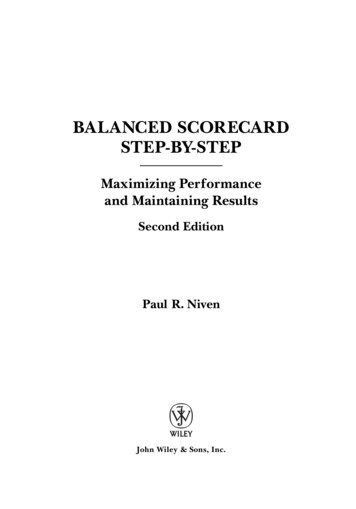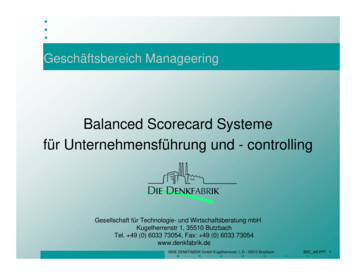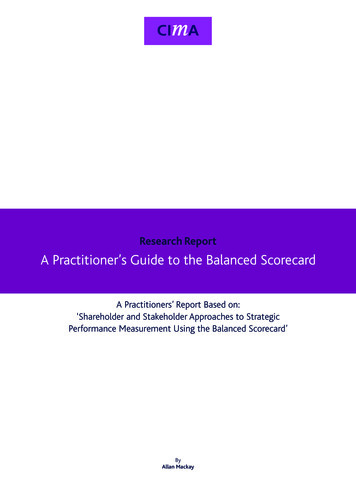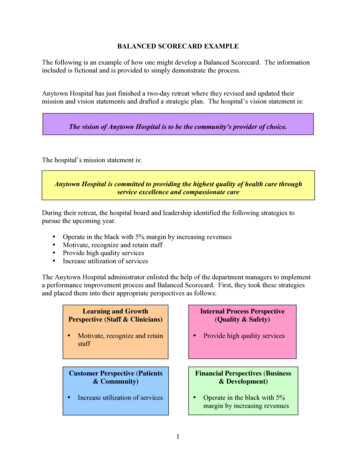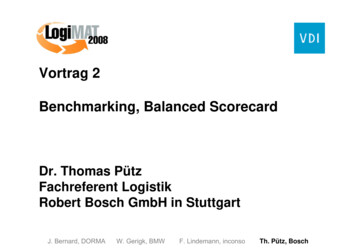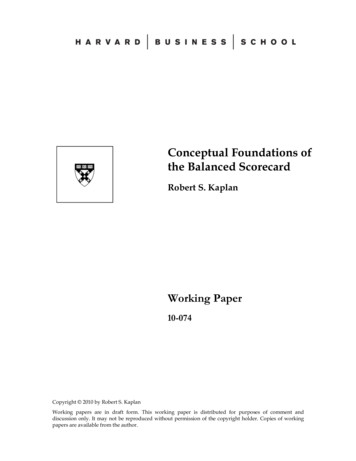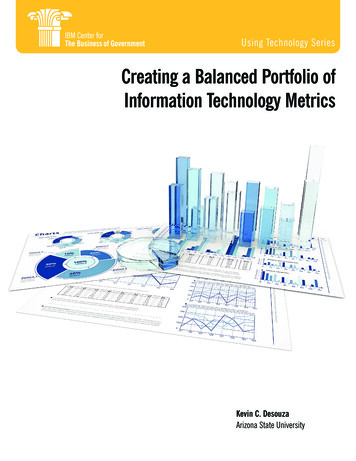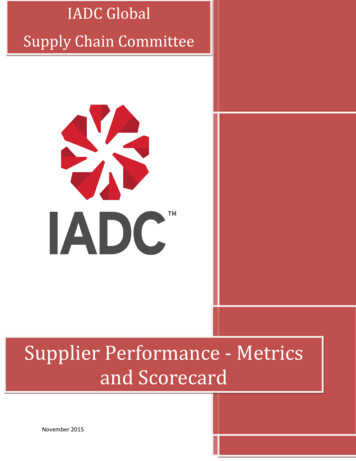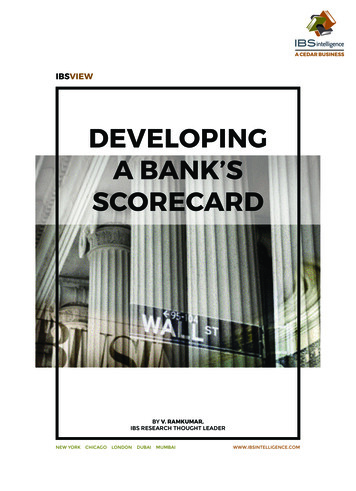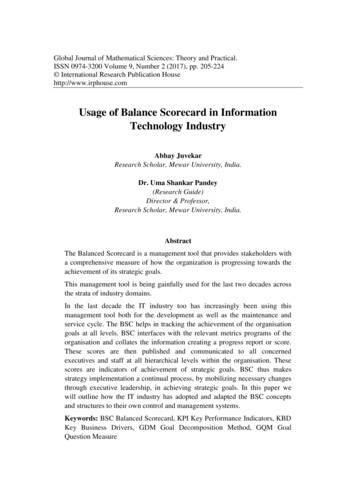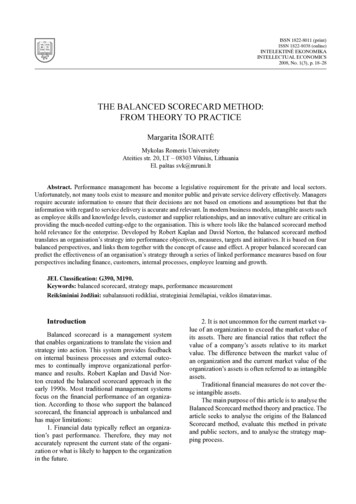
Transcription
ISSN 1822-8011 (print)ISSN 1822-8038 (online)INTELEKTINË EKONOMIKAINTELLECTUAL ECONOMICS2008, No. 1(3), p. 18–28THE BALANCED SCORECARD METHOD:FROM THEORY TO PRACTICEMargarita IŠORAITĖMykolas Romeris UniversitetyAteities str. 20, LT – 08303 Vilnius, LithuaniaEl. paštas svk@mruni.ltAbstract. Performance management has become a legislative requirement for the private and local sectors.Unfortunately, not many tools exist to measure and monitor public and private service delivery effectively. Managersrequire accurate information to ensure that their decisions are not based on emotions and assumptions but that theinformation with regard to service delivery is accurate and relevant. In modern business models, intangible assets suchas employee skills and knowledge levels, customer and supplier relationships, and an innovative culture are critical inproviding the much-needed cutting-edge to the organisation. This is where tools like the balanced scorecard methodhold relevance for the enterprise. Developed by Robert Kaplan and David Norton, the balanced scorecard methodtranslates an organisation’s strategy into performance objectives, measures, targets and initiatives. It is based on fourbalanced perspectives, and links them together with the concept of cause and effect. A proper balanced scorecard canpredict the effectiveness of an organisation’s strategy through a series of linked performance measures based on fourperspectives including finance, customers, internal processes, employee learning and growth.JEL Classification: G390, M190.Keywords: balanced scorecard, strategy maps, performance measurementReikšminiai žodžiai: subalansuoti rodikliai, strateginiai žemėlapiai, veiklos išmatavimas.IntroductionBalanced scorecard is a management systemthat enables organizations to translate the vision andstrategy into action. This system provides feedbackon internal business processes and external outcomes to continually improve organizational performance and results. Robert Kaplan and David Norton created the balanced scorecard approach in theearly 1990s. Most traditional management systemsfocus on the financial performance of an organization. According to those who support the balancedscorecard, the financial approach is unbalanced andhas major limitations:1. Financial data typically reflect an organization’s past performance. Therefore, they may notaccurately represent the current state of the organization or what is likely to happen to the organizationin the future.2. It is not uncommon for the current market value of an organization to exceed the market value ofits assets. There are financial ratios that reflect thevalue of a company’s assets relative to its marketvalue. The difference between the market value ofan organization and the current market value of theorganization’s assets is often referred to as intangibleassets.Traditional financial measures do not cover these intangible assets.The main purpose of this article is to analyse theBalanced Scorecard method theory and practice. Thearticle seeks to analyse the origins of the BalancedScorecard method, evaluate this method in privateand public sectors, and to analyse the strategy mapping process.
The Balanced Scorecard Method: from Theory to Practice1. Origins of the Balance ScorecardMethodThe Balanced Scorecard was developed byRobert Kaplan and David Norton (1992). In 1990,Kaplan and Norton led a research study of a lot ofcompanies with the purpose of exploring the newmethods of performance measurement. The importance of the study was a growing belief that financial measures of performance were ineffective forthe modern business enterprise. Representatives ofthe study companies, along with Kaplan and Norton,were convinced that reliance on financial measuresof performance had an affect on their ability to create value. The group discussed a number of possiblealternatives but settled on the idea of a scorecard,featuring performance measures capturing activitiesfrom throughout the organization—customer issues,internal business processes, employee activities, andof course shareholder concerns. Kaplan and Nortonintroduced the new tool the Balanced Scorecard andlater summarized the concept in the first of threeHarvard Business Review articles, “The BalancedScorecard—Measures That Drive Performance.”The Balanced Scorecard has been translated andeffectively implemented in both the nonprofit andpublic sectors. Success stories are beginning to accumulate and studies suggest the Balanced Scorecardis of great benefit to both these organization types.What is a Balanced Scorecard? The BalancedScorecard can be understood as a management system, which is structured according to the logic of themanagement circle (“plan-do-check-act”). The Balanced Scorecard resembles a typical managementfashion. For instance, Van den Heuvel & Broekmanwrote that “a self-respecting organization apparentlycan no longer do without the Balanced Scorecard”(1998) and Hers (1998) pointed to an abundance ofcongresses, seminars and publications on the theme.In crescendo, commentators spoke of “a real trend”(Koning & Conijn, 1997), “a fad-like impression”(Du Mée, 1996) and “a true hype”(Hers, 1998). Suchstatements suggest that the Balanced Scorecard hasbecome popular and brought about many changes ina variety of organizations. If the quoted authors areright, the Balanced Scorecard even resembles a typical management fashion.Kaplan and Norton position the Balanced Scorecard as a tool for organisations to manage the demands of relevant stakeholders and to translate strategies into action (“from strategy to action”). Possible stakeholders that are strategically relevant couldbe shareholders, customers or employees. Their demands are integrated into core management of com-19panies within a “financial”, “customer” or “learning”or “process” perspective (see Figure 1 below). So,the frame of the Balanced Scorecard consists of fourperspectives (see Figure 1). Each perspective consistsof relevant strategic goals, indicators and measures toachieve them. One should emphasize the fact that theconcept remains open for integrating further relevantstakeholders or perspectives, e.g. an environmentalperspective (Kaplan and Norton 1997, pp. 33). Whenconceiving the BSC, Kaplan and Norton, maintainedthat companies lack sophisticated tools for the management of intangible or qualitative assets (e.g. customer satisfaction, processes quality, infrastructures,know-how). Intangible assets, however, seem vital inorder to stay competitive in the future. So, the Balanced Scorecard provides ‘enablers’ that focus on theachievement of strategic goals in the future (leadingindicators) as well as results (lagging indicators) todepict the effectiveness and efficiency of measuresin the past. Strategies can be usually interpreted asa set of hypotheses of causes and effects. So withina BSC the relevant goals and corresponding indicators are linked to each other revealing this structureof causal relationships. Such relationships are bothrelevant within each perspective and also betweenthem. Objectives of the “learning” perspective, forinstance, serve as ‘enablers’ for the achievement ofgoals of the other ‘overarching’ perspectives (e.g.customers, finance).The BSC was originally created primarily asa measurement system and as an answer to a criticism concerning the unilateral measurement of theperformance ability of a company. It was organisedthrough four different perspectives:· The financial perspective: to succeed financially, how should we appear to our shareholders? Examples of this perspective include financial ratios and various cash flowmeasures.· The customer perspective: to achieve ourvision, how should we appear to our customers? Examples of this perspective includethe amount of time spent on customer callsand customer survey data.· The internal perspective: to satisfy our shareholders and customers, what business processes must we excel at? The internal businessprocesses that are often classified as missionoriented and support oriented. Examples ofthis perspective include the length of timespent prospecting and the amount of reworkrequired.· The learning perspective: to achieve our vision, how will we sustain our ability to change
20Margarita Išoraitėand improve? Includes employee trainingand organizational attitudes related to bothemployee and organizational improvement.Examples of this perspective include theamount of revenue that comes from new ideas and measures of the types and length oftime spent training staff.The starting point of the Balanced Scorecard isthe vision and the strategy of a company. The BSCtakes the vision and the strategy as a given - the BSCshould translate a business unit’s mission and strategy into tangible objectives and measures. The measurement focus of the BSC is used to accomplishthe following management processes: 1) clarifyingand translating vision and strategy, 2) communicating and linking strategic objectives and measures,3) planning, setting targets and aligning strategicinitiatives and 4) enhancing strategic feedback andlearning. The measures function as a link betweenthe strategy and operative action. The core questionis the selection of goals and measures to monitor theimplementation of the vision and the strategy.Kaplan and Norton recommend a nine-step process for creating and implementing the balanced scorecard in an organization.1. Perform an overall organizational assessment.2. Identify strategic themes.3. Define perspectives and strategic objectives.4. Develop a strategy map.5. Drive performance metrics.6. Refine and prioritize strategic initiatives.7. Automate and communicate.8. Implement the balanced scorecard throughoutthe organization.9. Collect data, evaluate, and revise.There are many benefits and challenges to thebalanced scorecard. The primary benefit is that ithelps organizations translate strategy into action. Bydefining and communicating performance metricsrelated to the overall strategy of the company, thebalanced scorecard brings the strategy to life. It alsoenables employees at all levels of the organization tofocus on important business drivers.The main challenge of this system is that it canbe difficult and time-consuming to implement. Kaplan and Norton originally estimated that it wouldtake an organization a little more than two years tofully implement the system throughout the organization. Some organizations implement it quicker,for some it takes longer. The bottom line is that thebalanced scorecard requires a sustained, long-termcommitment at all levels in the organization for it tobe effective.There are many benefits and challenges to thebalanced scorecard. The primary benefit is that ithelps organizations translate strategy into action. Bydefining and communicating performance metricsrelated to the overall strategy of the company, thebalanced scorecard makes the strategy come alive. Italso enables employees at all levels of the organization to focus on important business drivers.2. Comparing the Balanced Scorecardbetween private and public sectorsFigure 1. The methodology of the Balanced Scorecard (Kaplan and Norton, 1997, p. 9)Using the same performance metrics in the publicsector as the private sector islikely to be ineffective since public sector goals differdrastically from those of theprivate sector. Private sectorfocus is primarily on shareholder value: the bottomline. Funding comes fromvarious sources, and as longas shareholder financial needs are met, the companycan function as it pleases(see table 1). The publicsector faces a quite differentenviron ment. Public sector funding comes, in mostcases, from the taxpayers itis servicing. the measure of
21The Balanced Scorecard Method: from Theory to Practicesuccess is not shareholder value orprofit but rather how well the agencyis meeting the mission given to themby congressional statute or executiveorder. Although the agency can oftentimes perform this mission in whatever way it sees fit, it is still boundby the directive of the mission. thus,strategic value comes in the form offulfilling the mission, and ful fillingthe mission comes down to customersatisfac tion with the agency’s service.however, defining customer needs isa bit more complex. A second difference evolves through the number ofcustomers or stakeholders that a public sector organization must serve.Financial measures in the BSCrelate to financial performance, whichis a means to satisfy investors (shareholders, investment firms, bondholders). in the public sector organiza tion, the financial measures are justpart of what is needed to please the“investors,” which in this case wouldbe the funding agencies.Figure 2. Comparing the Scorecards for Government Versus For-ProfitOrganizations (Nicholas J. Mathys, 2006)Table 1. Comparison of Balanced Scorecards in the Privateand Public Sectors (source Nicholas J. Mathys, 2006)FeaturesFocusPrivate SectorPublic SectorShareholdervalueProfit; marketshare growth;innovation; creativityMissioneffectivenessCost reduction;efficiency; accountability to the publicEfficiency concerns of clientsDesired xpayers; legislators; inspectorsWho definesbudget prioritiesCustomerdemandLeadership; legislators; fundingagenciesKey s; economies of scale; standardized technologyFinancial goalsCustomer satisfac- Stakeholder satistionfactionWhile private sec tor clients are not concernedwith an organization’s internal efficiency so longas their product, price, and service needs are met,internal efficiency is of great concern to the publicsector’s stakeholders, who are also its source of fun-ding. taxpayers also require accountability that theirtax dollars are being used effectively and efficiently. Therefore, program performance, efficient use ofresources, and satisfac tion with the service by thepublic are additional key issues. These differenceslead to a d
The Balanced Scorecard Method: from Theory to Practice 21 success is not shareholder value or profit but rather how well the agency is meeting the mission given to them by congressional statute or executive order. Although the agency can often-times perform this mission in wha-tever way it sees fit, it is still bound by the directive of the mission. thus, strategic value comes in the form of .
